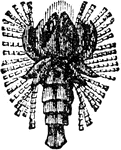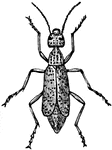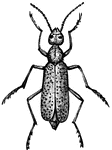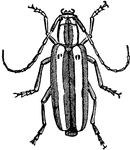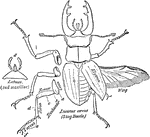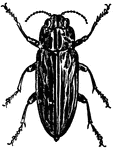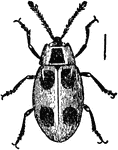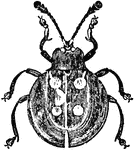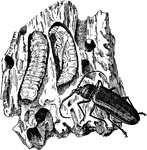
Beetle
Beetles are the group of insects with the largest number of known species. The general anatomy of beetles…
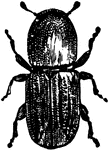
Bark Beetle
A bark beetle is one of approximately 220 genera with 6,000 species of beetles in the subfamily Scolytinae.…

Blister Beetle
Beetles (Coleoptera) in the family Meloidae are commonly known as blister beetles, after their defensive…

Carrion Beetle
"Carrion-beetle (Silpha inaequalis). a, larva; d, same; f, g, h, mandible, labium, and maxilla of larva;…

Click Beetle
The family Elateridae is commony called click beetles (or "typical click beetles" to distinguish them…
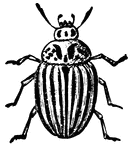
Colorado Potato Beetle
The Colorado potato beetle (Leptinotarsa decemlineata), also known as the Colorado beetle, ten-striped…
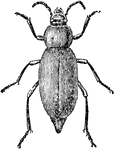
Darkling Beetle
Darkling beetles (also known as Darkening beetles) are a family of beetles found worldwide, estimated…
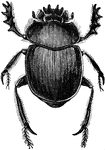
Dung Beetle
The dung beetle is an insect in the Scarabaeidae family and was a sacred icon to the Egyptians.
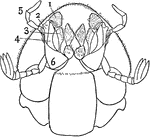
Ventral View of Dung Beetle
"Under Surface of Head of Tumble-bug (Copris carolina), about four times natural size. 1, galea; 2,…

Grapevine Flea Beetle
The Grapevine Flea Beetle (Altica chalybea). "a, leaf infested with larvae; b, larva; c, cocoon; d,…
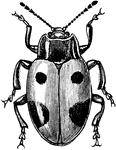
Handsome Fungus Beetle
The Handsome Fungus Beetle (Endomychus biguttatus) is an insect in the Cucujoidea superfamily of beetles.
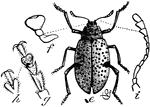
Fungus Beetle
Erotylus boisduvali, a fungus beetle. "e, beetle; f, palpus; g, tarsus, from below; h, terminal joint…

Goliath Beetle
The Goliath beetles are among the largest insects on Earth, if measured in terms of size, bulk and weight.…

Saw-Toothed Grain Beetle
The Saw-Toothed Grain Beetle (Oryzaephilus surinamensis) is a beetle of the Silvanidae family and is…

Ground Beetle
Ground beetles or carabids are collective terms for the beetle family Carabidae. This is a large family,…

Dorsal View of Ground Beetle
The dorsal view of the Ground Beetle (Evarthrus orbatus), an insect in the Carabidae family of carabid…

Hercules Beetle
The Hercules beetle (Dynastes hercules) is the most famous of the rhinoceros beetles. Native to the…

Ivory-Marked Beetle
The Ivory-Marked Beetle (Eburia quadrigeminata) is an insect in the Cerambycidae family of longhorn…
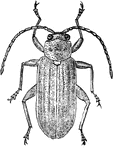
Dorsal View of Leaf Beetle
Galeruca notata is a beetle species in the Chrysomelidae family of leaf beetles.
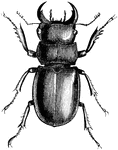
Longhorn Beetle
The longhorn beetles (Cerambycidae; also known as long-horned beetles or, more archaically, llongicorns)…
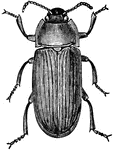
Mealworm Beetle
Mealworms are the larva form of the mealworm beetle, Tenebrio molitor, a species of darkling beetle.…
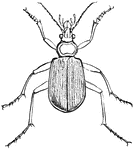
Predaceous Beetle
Predaceous diving beetles is a family of water beetles. They are about 25 mm (one inch) long on average,…

Predaceous Beetle
Predaceous diving beetles is a family of water beetles. They are about 25 mm (one inch) long on average,…
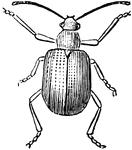
Grape Rootworm Beetle
The Grape Rootworm Beetle (Fidia viticida) is an insect in the Chrysomelidae family of leaf beetles.
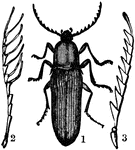
Serricorn Beetle
"1. A serricorn beetle (an elater). 2, 3. Englarged antennae of other serricorns (species of Phyllocerus…

Tiger Beetle
The tiger beetles are a large group of beetles known for their predatory habits. Some tiger beetles…

Metallic Wood-Boring Beetle
Gyascutus planicosta is a species of Metallic Wood-Boring Beetles in the Buprestidae family.

Woodboring Beetle
The term woodboring beetle encompasses many species and families of beetles whose larval or adult forms…
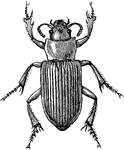
Caraboid Beetle
"Geopinus incrassatus. GEOPINUS. A genus of caraboid beetles, of the subfamily Harpalinae, having the…
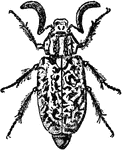
Cockchafer
The cockchafer (colloquially called may bug, billy witch, or spang beetle, particularly in East Anglia)…
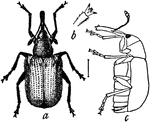
Rose Curculio
"Rose-curculio (Rhynchites bicolor). a, beetle; c, same in profile; b, claw." -Whitney, 1911
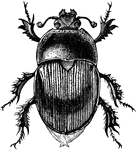
Drone Beetle
"Drone-beetle (Geotrypes splendidus). GEOTRYPES. A Fabrician genus of beetles typical of the family…

Common Eastern Firefly
"Common Firefly (Photinus pyralis). a, larva; b, pupa in its earthen cell; c, beetle. d, e, f, leg,…

